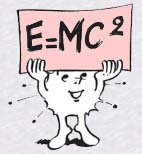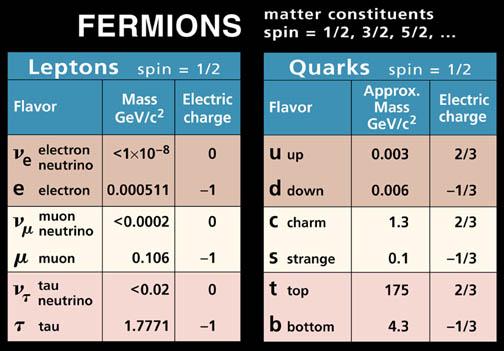or
Antimatter and fossil matter
![]() Antimatter
Antimatter
Antimatter is composed of antiparticles: antiquarks, anti-electrons,
antineutrinos.
We've seen before that all particles are characterised by properties
quantified by quantum numbers. For example the electric charge Q
and the spin number J, but also other grandiose names as esoteric as the
baryon number B, the lepton number L, the isospin T, the strangeness S,
the hypercharge Y or the charm C!
An antiparticle is simply a particle with opposing quantum numbers.
It was in 1927 that Paul Dirac imagined (like the mathematical
solutions named after him) the existence of antiparticles. In 1932,
the american Carl Anderson detected some anti-electrons (christened positrons
as a result of their positive charge Q) amongst the particles produced
by the impact of cosmic rays on the atmosphere.
A supernova is a massive star which ends its life in a gigantic explosion which emits in several weeks a light as powerful as a galaxie containing many million of stars. An explosion such as this creates a shock wave in the interstellar locality (full of gas and magnetic charge), and plays the role of a natural accelerator of electrically charged particles. The analysis of this cosmic ray at altitude has for a long time been the only means for physicists to study and discover new particles. It was necessary to wait for the 1950s to reproduce this type of very energetic ray in the accelerators. |
Lets dream of antiparticles:
Thus for each particle there is a corresponding symetrical anti-particle.
These anti-particles can assemble themselves; in this way on 4th January
1996, CERN in Geneva announced the fabrication of nine atoms of antihydrogen.
![]()
![]() Annihilation
Annihilation
If a particle meets its antiparticle, their two masses are converted entirely into energy (gamma rays): This is the phenomena of annihilation that physicists can reproduce in colliders.
 Moreover
it is the only phenomena where the totality of a mass is transformed into
energy in accordance with Ensteins celebrated formula E=mc2.
This colossal energy released by such a particle-antiparticle encounter
can rapidly transform itself into other massive particles: this is the
inverse phenomena of materialisation of energy.
Moreover
it is the only phenomena where the totality of a mass is transformed into
energy in accordance with Ensteins celebrated formula E=mc2.
This colossal energy released by such a particle-antiparticle encounter
can rapidly transform itself into other massive particles: this is the
inverse phenomena of materialisation of energy.
This explains why there is no antimatter in our matter based environment:
all traces of antimatter will be annihilated at the least contact with
our world. Furthermore it seems that our entire Universe is composed of
nothing but matter.
Why has the Universe opted for one single form of matter? the question
is not entirely resolved at this moment in time.
Astrophysicists suppose that 10-32
seconds after the Big Bang, the entire Universe was nothing but a symmetrical
melange (at a temperature of 1026 degrees)
of quarks, neutrinos and electrons and of their respective antiparticles.
This resulted in an uninterrupted succession of annihilation and of materialisation
bathing in a bath of very high energy photons. No material would have been
able to emerge from this infernal chaos if a perfect symmetry had been
respected between matter and antimatter. Now a minute quantity of matter
has survived total annihilation; a particle of matter for a million particle-antiparticle
pairs annihilated!
This asymmetry, luckily for us, was not possible but thanks to the
"breakage of CP symmetry" discovered in 1967 by Andreï Sakharov,
the father of the soviet H bomb.
![]()
![]() CP
symmetry:
CP
symmetry:
Conjugation of C and P gives CP symmetry: particles which change,
after interacting, their quantum numbers conforming to C and P symmetry,
should be able to do so in both senses. But justly this CP symmetry is
not respected; which is equivalent to saying that matter and antimatter
don't behave exactly the same!
To be more exact, this CP symmetry is violated by one of the 4 universal
forces, the most mysterious one called the weak
interaction.
![]()
![]() How
to imagine a nucleon? (by Etienne Klein)
How
to imagine a nucleon? (by Etienne Klein)
| At the centre of the atom, within the nucleus, we can imagine a hullabaloo of protons and neutrons. Glued together by powerful forces, they bustle violently in all directions. In each proton, in each neutron, another dance : three quarks, always three, agitated by tremendously rapid movements. In the course of a terribly violent impact, it happens that the energy of these quarks transforms into matter; a new pair of particles then bursts out : a quark and an antiquark. Inversely, when a quark and an antiquark meet, they destroy each other and transform into energy. And so on: quarks and antiquarks appear, meet, disappear in the course of fleeting catastrophies which repeat incessantly. Curiously, a certain order reigns in the quivering chaos: in effect, there is always, in each proton, three quarks more than antiquarks. |
![]()
![]() Other
families of fermions
Other
families of fermions
Our table of 4 fermions + 4 antifermions is it complete?
Not yet...
There exist in fact, two other families of fermions analogous to our
family u-d-electron-neutrino:
| QUARKS | LEPTONS | |||
| Q charge | Q = -1/3 | Q = +2/3 | Q = -1 | Q = 0 |
| family 1 | down = d | up = u | electron | electronic
neutrino |
| family 2 | strange = s | charm = c | muon | muonic
neutrino |
| family 3 | bottom = b | top = t | tau | tau
neutrino |
Each lepton is associated with a specific neutrino.
The quarks have been christened with poetic names which correspond
to their "flavours". Nothing to do with the taste, but the 6 flavours
of quarks characterise the influence of the weak interaction upon them.
Family 2:

![]()
![]() What
it still needed to explain matter?
What
it still needed to explain matter?
We are still missing a fundamental family of particles: the bosons
that form part of the photon, a quantum grain of light. Bosons are very
special particles which do not respect Paulis exclusion principle. Bosons
can be superimposed in the same quantum state in contrast to the fermions
which are individualised in space.
These bosons are in addition, mediator particles of the 4 fundamental
forces of the Universe: the interactions without which our particles
of matter couldn't be bound together.
Once these 4 fundamental interactions are defined, we will finally have all of the elements which constitute the present theory of the Standard Model: this is the theory which explains all observable phenomena at the scale of the particles...
|
|
The ultimate elementary particles are resourceful
snobs:
|